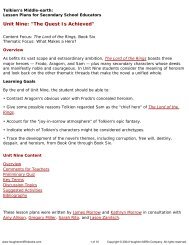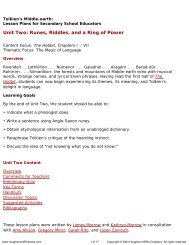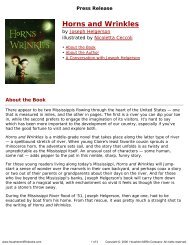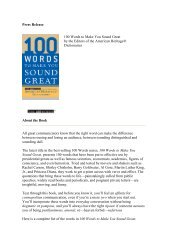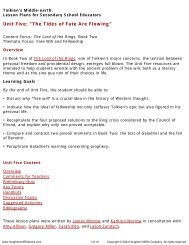Lesson Plans, Unit Three: There and Back Again - Houghton Mifflin ...
Lesson Plans, Unit Three: There and Back Again - Houghton Mifflin ...
Lesson Plans, Unit Three: There and Back Again - Houghton Mifflin ...
Create successful ePaper yourself
Turn your PDF publications into a flip-book with our unique Google optimized e-Paper software.
Tolkien's Middle-earth:<br />
<strong>Lesson</strong> <strong>Plans</strong> for Secondary School Educators<br />
<strong>Unit</strong> <strong>Three</strong>: <strong>There</strong> <strong>and</strong> <strong>Back</strong> <strong>Again</strong><br />
Key Terms<br />
quest (qwest) An expedition undertaken to find or achieve something. The Hobbit tells of<br />
Thorin Oakenshield's quest to regain his people's wealth, stolen by Smaug. The word quest<br />
enters our language through quaesta, a form of the Latin verb meaning "to seek."<br />
legend (lej-end) A story passed down for generations, conceivably rooted in an actual<br />
person or event. Examples include the legend of Robin Hood <strong>and</strong> the legend of King Arthur.<br />
Early in The Hobbit, the narrator recounts a humorous legend that supposedly explains the<br />
origins of golf.<br />
symbolism (sim-ba-liz-em) The literary device of using concrete particulars to represent<br />
abstract ideas. When Bilbo imagines himself wearing "a sword instead of a walking-stick,"<br />
Tolkien is using the walking-stick to symbolize everyday life <strong>and</strong> the sword to symbolize<br />
adventure.<br />
allegory (al-a-gor-ey) A literary work in which each major character <strong>and</strong> event has a fixed<br />
meaning. In Edmund Spenser's epic The Faerie Queen, the ruler Gloriana represents Queen<br />
Elizabeth <strong>and</strong> the Red Cross Knight symbolizes Holiness. George Orwell's novel Animal Farm<br />
is largely an allegory of the Russian Revolution. Although allegories often take the form of<br />
quest stories, Tolkien explicitly rejected allegorical interpretations of his fiction.<br />
animism (an-e-miz-em) The belief that every living thing is endowed with a soul <strong>and</strong> a<br />
personality. When Tolkien uses talking birds in The Hobbit, he is evoking the animistic world.<br />
hoard (hord) A supply of something valuable, such as money or food, that is carefully<br />
guarded. In The Hobbit, the dragon Smaug keeps a hoard of stolen treasure. The word<br />
comes from the Old English hord via an Indo-European verb meaning "to cover."<br />
bard A Celtic word for a poet. In The Hobbit, Bard is the name of the Lake-town man who<br />
slays Smaug.<br />
www.houghtonmifflinbooks.com 4 of 20 Copyright © 2004 <strong>Houghton</strong> <strong>Mifflin</strong> Company. All rights reserved.



